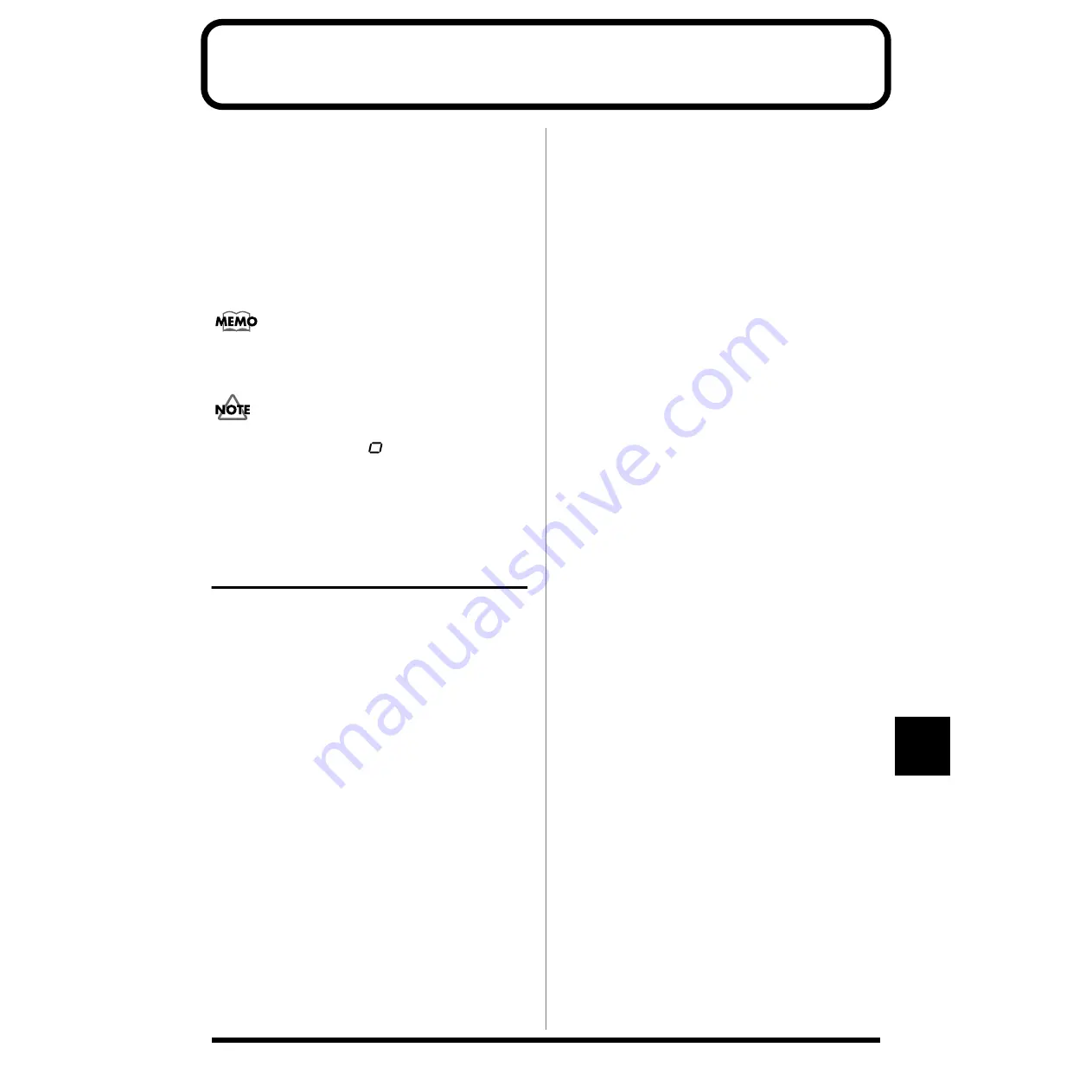
119
11
Chapter 11 Creating User Styles
You can create and store up to maximum 20 different User
Styles. Just as with the Preset Styles, each Style eight Forms
can be used in the composition of each Style.
Recording of User Styles can also be done using
Realtime
Recording
.
Although you can record performances just as they are
played using Realtime Recording,
you cannot conduct
Realtime Recording using the JS-5 by itself
.
Record performance patterns by playing a MIDI keyboard
connected to the JS-5’s MIDI IN connector.
The force with which the keys of the MIDI keyboard are
pressed (the velocity) is recorded in eight levels.
Only note information (p. 131) is recorded to the User Style.
Never turn off the power to the JS-5 or remove the memory
card from the JS-5 while the “
” still appears at the left of
the display (when data is being written), as this can prevent
the data from being written properly, and may adversely
affect later operations.
Points to Note When
Creating User Styles
To ensure that the User Song correctly plays the chord progression
specified on the Chord track, create your performance data using
chords with “C” as the root or phrases in the key of “C.”
This way, the Arranger function converts the various chords based
on the sounds being in the key of “C” or on “C” chord sounds.
When only chords are being played, such as with chord
backing, create the performance data using chords with “C”
as the root (examples of such chords include “C6” (C, E, G,
A) and others). This way, when the “ARPEGGIO” settings in
Arrange mode (refer to the following)
are selected, the
sounds in the performance data are arranged to fit the notes
making up the chords. However, using these Arrange mode
settings does not allow you to play notes other than those
making up the chords.
Using a different technique, though, you can not only
compose chords, but also play melodious phrases that match
the chord progression. In this case, phrases are created in the
key of “C.” This way, when the “OBBLIGATO” is selected in
Arrange mode, the sounds in the performance data are
arranged to fit the scales of the notes making up the chords.
However, since the “OBBLIGATO” settings allow you to
play notes other than those making up the chords, there may
be times when, depending on the data, you may not be able
to get a sense of the chords being played.
* When playing Styles exactly as composed, that is without the
chords being converted, input N.C. (Non-Chord Type) to the
Chord track (p. 72). Doing this allows you to create songs
using each Style as an independent pattern. However, this uses
more Styles than in Songs where the chords are converted, so
this method also consumes that much more memory.
About Arrange Mode
You can change the way Chords are converted (the
arrangement) by setting the User Style to Arrange mode.
* You cannot change the Arrange mode of the Drum Parts (this
is fixed at NO ARRANGE).
* Suitable Arrange modes have been selected for the Preset
Styles. When changing the Arrange mode of a Preset Style,
make these changes after first copying (p. 124) the Preset Style
to the User Styles.
NO ARRANGE:
Performance data on tracks set to “NO ARRANGE” is
performed just originally played, with no arranging (Chord
conversion). Drum Parts are held to this mode.
BASS:
This setting is meant for bass performances. Just as with
“OBBLIGATO,” notes in the performance data are
automatically shifted to notes in scales matching the Chords.
Furthermore, notes higher than those in the bass registers are
shifted down an octave. Additionally, when On-Bass Chord
is selected, the root tone is transposed to the bass note.
OBBLIGATO:
This is best for Performances including melodious phrases.
The notes in the performance data are shifted to notes in
scales matching the Chords.
ARPEGGIO:
This is good for arpeggios and Chords. The notes in the
performance data are converted to notes in the Chords that
are input. This mode plays other converted notes that are not
central to the chord.
* If you do not want to send all of the on the Style’s Performance
track performance data through the Arranger, input “C” for
the Chord track and “N.C (- -)” for the Chord type. N.C sets
the Style to play the Chords just as they are in the performance
data, without converting the Chords.
* Inputting N.C. (Non-Chord Type) to the Chord track disables
the Arrange mode settings for the Style being performed.






























